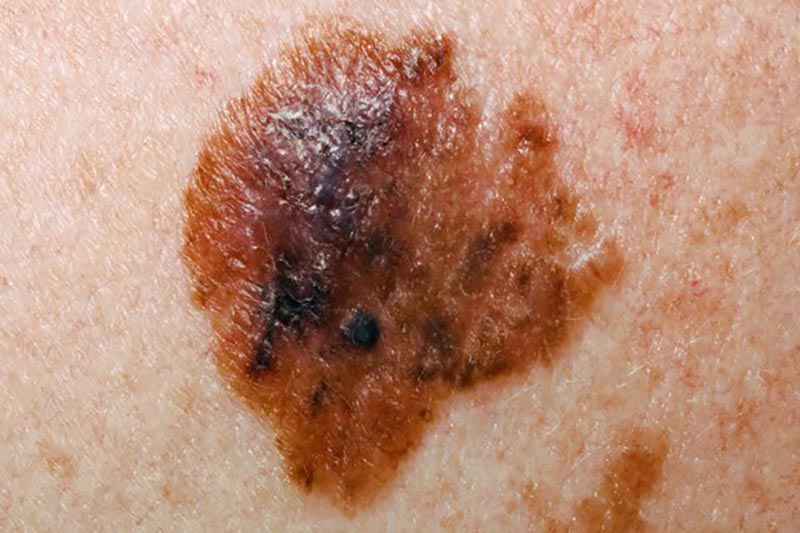
Central Coast: melanoma hotspot
The Cancer Institute NSW’s newly released melanoma hotspot map reveals that the Central Coast has been included in the state's top 25 for melanoma incidence. Ballina, Lismore, Byron, Clarence Valley and Coffs Harbour local government areas (LGAs) have the state’s highest rates of melanoma, with almost 350 cases projected to be diagnosed in those areas in 2024.

Melanoma skin cancer.
6 November 2024
MELANOMA is one of the most common cancers among young Australians and the third most diagnosed cancer in NSW, with more than 5000 people expected to be diagnosed in the state in 2024.
As the most serious form of skin cancer, melanoma can be deadly and is projected to take the lives of close to 500 people across NSW this year.
Ninety-five per cent of melanoma and 99 per cent of non-melanoma skin cancers are caused by overexposure to UV radiation from the sun and can be prevented with proper sun protection.
NSW Health Minister Ryan Park said, “The release of the latest melanoma hotspot map is a timely reminder, particularly as we head into summer, to always take protective measures when outdoors.
“Most melanoma hotspots are in regional areas but it’s important to remember that no matter where you live, the risk of skin cancer is ever present.
“Australia has one of the highest skin cancer rates in the world and as a community, it’s imperative we take the threat of skin cancer seriously and follow the simple, life-saving steps needed to reduce our risk of this deadly disease.”
The Cancer Institute NSW has several initiatives in place to reduce the impact of skin cancer in NSW as part of its Skin Cancer Prevention Strategy 2023-2030. Initiatives include the If You Could See UV campaign, which is about to be relaunched in time for summer.
The behaviour change campaign, which aims to motivate 18–24-year-olds to protect their skin from UV radiation, has recently received two prestigious Australian Effectiveness Awards (Effies) for Positive Change, and Insight and Strategic Thinking.
Research shows more than 75 per cent of young people felt motivated to protect their skin from the sun after watching the campaign, which will deliver geo-targeted reminders on weather apps and outdoor advertising of the UV index in areas of NSW where young people are more likely to be outdoors.
The most effective defence against UV radiation is to follow these five key steps before leaving the house:
- Slip on protective clothing
- Slop on SPF50+ sunscreen. Sunscreen should always be applied 20 minutes before heading outdoors and re-applied every two hours.
- Slap on a wide brimmed hat
- Seek shade
- Slide on sunglasses.
NSW Chief Cancer Officer and Chief Executive Cancer Institute NSW, Professor Tracey O’Brien AM that two out of three Australians will be treated for skin cancer in their lifetime. "This is why protecting our skin from the sun from a very young age, and into adulthood, is key to reducing our risk of this devastating disease."
“In NSW, UV radiation levels are high 10 months of the year and even short bursts of exposure to the sun can be deadly," she said.
“Whether you’re going to the beach or hanging the washing or walking to the shops or train station, I urge everyone to do the simple things like seeking shade when outdoors, wearing sunscreen, putting on a hat, sunglasses and protective clothing to safeguard themselves from harmful UV radiation from the sun.”
Anne Gately was diagnosed with melanoma at age 44 in 2010 and after having the mole and some lymph nodes removed. "I was given the all clear. Eight years later I was diagnosed with stage 4 melanoma, but thankfully after receiving immunotherapy treatment I was cancer free within three months.
“I was a tanner, so I spent a lot of time at the beach, and I also spent a lot of time playing sport, which is why I think it’s not just about personal responsibility but that we have a duty of care to others in our community when it comes to sun protection.
“I think the campaign is spot on, in spreading the message that while you may not be able to see or feel the consequences every amount of UV exposure is adding to the damage.”
Sonia Knight, who at age 43 noticed a mole on my arm that was changing and looked nasty. A visit to her GP confirmed that it was a melanoma, which had spread to some lymph nodes.
Sonia had the mole emoved and was cancer free for five years, until July this year when she received news the melanoma had returned at stage 3c. "I had surgery recently and will soon start immunotherapy," she said.
“I grew up on Northern Beaches and spent every weekend at the beach, I thought a tan was healthy looking but now I tell everyone, tanning is definitely not cool and how important it is to protect your skin from the sun – my daughters don’t leave the house unless they’re applied sunscreen half an hour beforehand.
“I have lent on many services that I didn’t even know existed including Canteen, Melanoma Patients Australia and Cancer Wellness and would encourage others to seek out this sort of vital support.”
More information on how to reduce your risk of skin cancer is available on the Cancer Institute NSW website.







.jpg?crc=4257584689)










_web.jpg?crc=282450513)



